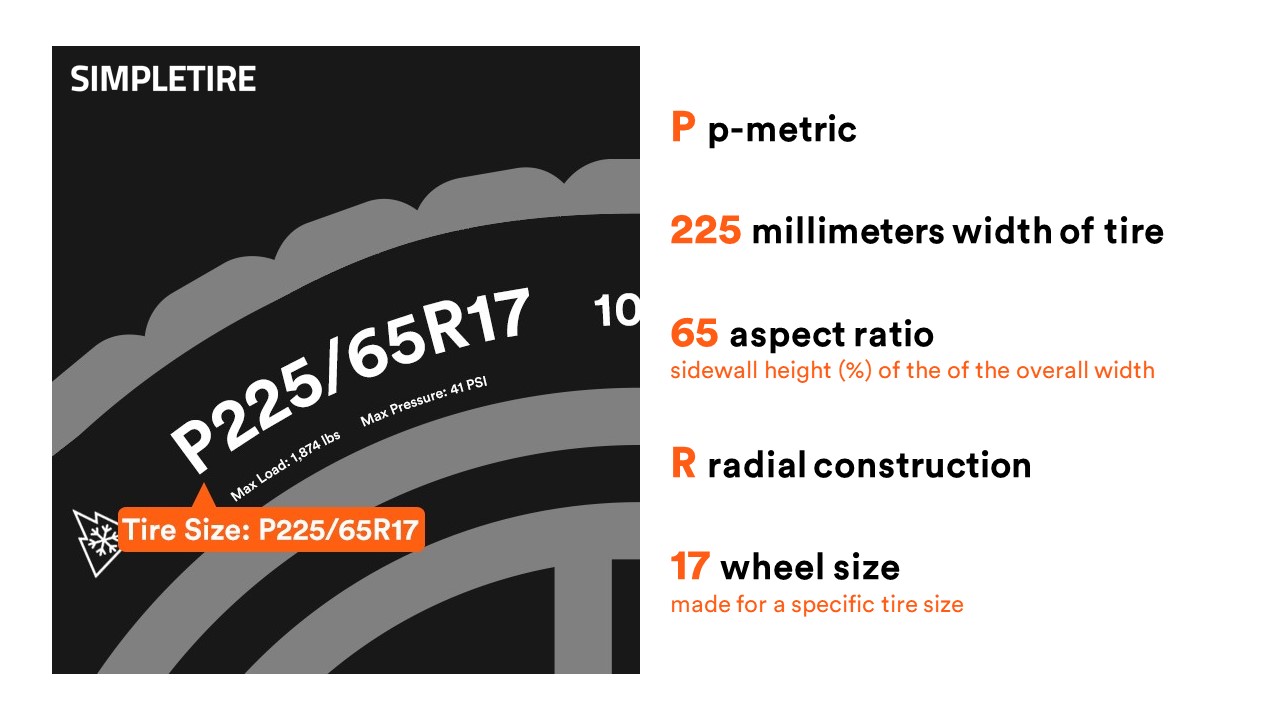Tire buying guides
Free shipping
Best price guarantee
Special pricing
Financing with Resolve
Easy returns
Every vehicle requires specific tire dimensions to operate safely and efficiently. These measurements directly impact your car's handling, fuel economy, and overall performance on the road.
Finding the correct tire size involves more than simply matching numbers—it requires understanding what those numbers mean and where to locate them. Vehicle manufacturers design each model with precise tire specifications that optimize everything from braking distance to speedometer accuracy.
Most drivers discover their tire size needs during replacement shopping or when considering aftermarket wheels. The process becomes straightforward once you know where to look and how to interpret the information available on your current tires, vehicle documentation, and manufacturer resources.
What is tire size?
Tire size represents a standardized code that communicates essential measurements and performance characteristics of a tire. This alphanumeric sequence appears on every tire's sidewall and contains critical information about width, height proportions, construction type, wheel diameter, load capacity, and speed rating.
The most common format follows a pattern like P215/65R15 91S. Each element serves a specific purpose: the "P" indicates passenger vehicle use, "215" shows the width in millimeters, "65" represents the aspect ratio as a percentage, "R" denotes radial construction, "15" specifies the wheel diameter in inches, "91" indicates the load index, and "S" shows the maximum speed rating. Understanding these components helps ensure proper fitment and safe operation.
How to Determine the Correct Tire Size for Your Car
Choosing the right tire size is vital for ensuring your vehicle operates safely and efficiently. Each element of the tire size code provides specific details that are necessary for selecting compatible tires. Incorrect sizing can lead to problems with stability, comfort, and even mechanical issues. Here’s a step-by-step guide to finding your tire size:
Step 1: Check the Tire Sidewall

Your tire's sidewall provides essential details that guide you in selecting the right replacement. This area displays an alphanumeric sequence packed with information about your tire's size and capabilities. Deciphering this code ensures any new tire aligns perfectly with your vehicle's requirements.
Interpreting the Sidewall Sequence
- Overall Width: The initial three-digit figure denotes the tire's section width, measured in millimeters. This dimension influences the tire's footprint on the road, contributing to grip and stability.
- Height-to-Width Ratio: After the width, a slash precedes a two-digit number known as the aspect ratio. This percentage indicates the tire's profile height compared to its width, affecting both ride comfort and handling dynamics.
- Structure and Wheel Fitment: "R" indicates radial construction, a standard in modern tires, followed by a number specifying the wheel's diameter in inches. This measurement guarantees compatibility with your existing wheels, ensuring a correct fit.
Why Accurate Sidewall Reading Matters
Properly interpreting the information on your tire's sidewall is crucial for choosing suitable replacements. Overlooking these specifications can lead to tires that negatively impact your vehicle's performance, efficiency, and safety. By understanding the sidewall details, you lay the groundwork for maintaining your vehicle's optimal operation.
Step 2: Consult Your Vehicle's Manual
The vehicle's manual is an invaluable tool for identifying the correct tire size specific to your car model. Created by the manufacturer, this document delivers key information that aligns with your vehicle's design specifications. These guidelines ensure that the tires you choose enhance the vehicle's intended performance and safety features.
Key Information from the Manual
- Tire Size Recommendations: The manual lists sizes that are engineered to provide the best balance of handling, comfort, and efficiency for your specific vehicle model.
- Weight and Speed Compatibility: Following the manual's guidance on weight and speed capabilities helps maintain safe operation. Ensuring that your tires meet these criteria supports optimal vehicle performance under various driving conditions.
- Pressure Specifications: The manual also provides recommended tire pressure levels, which are vital for prolonging tire life and optimizing fuel consumption. Proper inflation contributes significantly to improved traction and overall driving safety.
Why the Manual Matters
Relying on your vehicle's manual ensures that the tires you select are in harmony with the car's design parameters. This approach helps prevent mismatches that could lead to premature tire wear or altered handling characteristics. By aligning with the manufacturer's standards, you preserve the vehicle's performance and durability on the road.
Step 3: Use a Tire Size Calculator
Digital tire size calculators are essential for drivers aiming for accuracy when selecting new tires. These tools streamline the process by allowing you to enter specific details about your vehicle or its current tires. This method ensures a precise match with your vehicle's design and performance needs.
How to Utilize a Tire Size Calculator
- Enter Vehicle Details: Start by inputting details such as your vehicle's make, model, and year. This information enables the calculator to pull from a comprehensive database of recommended tire sizes specific to your vehicle's specifications.
- Input Existing Tire Specifications: Another option is to input the size details of your current tires. This approach facilitates a comparison of various sizes to explore enhancements in driving experience while maintaining safety and performance.
Benefits of Using a Tire Size Calculator
- Thorough Comparison: The calculator provides a comparative analysis of different tire sizes, illustrating variations in aspects like handling, traction, and efficiency. This helps you make informed decisions based on the performance characteristics of each option.
- Adaptability: For those considering custom modifications, the calculator identifies suitable alternative sizes that fit within your vehicle's operational parameters. This ensures any size changes do not affect your vehicle's systems or compliance with regulations.
- Efficiency: Accessing a tire size calculator online delivers instant feedback, eliminating uncertainty and reducing time spent on research. This tool empowers you to make well-informed choices that cater to your specific driving requirements.
Step 4: Find Tire Size by VIN Number
Every vehicle has a distinct Vehicle Identification Number (VIN), which contains detailed information about the car's original features, including the recommended tire size. This 17-character identifier can be located in multiple places on your vehicle, such as on the driver's side dashboard near the windshield or printed on the label inside the driver's side door.
Discovering and Applying the VIN
- Find the VIN: Start by spotting the VIN on your vehicle. Common locations include the visible area through the windshield on the driver's side or inside the driver's door jamb. It might also appear on official documents like vehicle registration.
- Unlock the VIN's Details: Use an online VIN decoder to extract comprehensive details about your vehicle. These tools translate the VIN into a complete profile that includes manufacturer-recommended tire sizes, ensuring your selections align with the vehicle's intended design for safety and performance.
Advantages of Using VIN-Based Tire Sizing
- Exactness: The VIN provides precise tire size information tailored to your vehicle model, ensuring an accurate fit that supports optimal driving conditions.
- Thorough Overview: Decoding the VIN offers a full picture of your vehicle's specifications, assisting in making well-informed decisions about maintenance and possible upgrades.
- Dependability: Relying on VIN data for tire sizing helps maintain compliance with original manufacturer specifications, protecting against mismatches that might affect driving safety and efficiency.
Step 5: Consider Rim Compatibility
Choosing the right tire size involves more than just the tire itself—it's equally important to ensure compatibility with your rims. Matching tires with the correct rims maintains vehicle safety and performance. Evaluating rim compatibility ensures that your selection provides the necessary support and stability.
Understanding Rim Specifications
- Diameter: Ensure the tire's diameter aligns with the rim's size. For example, a tire meant for a 16-inch rim will not fit correctly on a rim of a different size, which can affect safety and performance.
- Width: The width of the rim affects tire performance characteristics. A wider rim can enhance handling by reducing sidewall flex during turns, but it should fall within the tire’s recommended range to avoid uneven wear.
- Bolt Pattern and Offset: These determine how the rim attaches to your vehicle. The bolt pattern refers to the number and spacing of the lug holes, while the offset measures the distance from the hub mounting surface to the rim's centerline. Aligning these with your vehicle's specifications is crucial for proper fitment.
Ensuring Proper Rim and Tire Pairing

- Consult Reliable Sources: Check resources like the vehicle owner's manual or tire manufacturer specifications to ensure your chosen rims and tires fit the vehicle's design. This alignment supports your vehicle's suspension and braking systems.
- Get Expert Input: When uncertain, consult with a tire specialist. Their expertise can confirm that your selected tires and rims work together effectively, preventing fitment issues and maintaining driving dynamics.
Finding the right tire size for your vehicle doesn't have to be complicated when you follow these straightforward steps. By checking your sidewall, consulting your manual, and using the proper tools, you can confidently select tires that match your vehicle's exact specifications. Ready to put your new knowledge to use? Shop for tires online and find the best deals - we make it easy to search by your vehicle's make and model, ensuring you get the perfect fit delivered right to your door.
Ready to find the perfect tires?
Search By